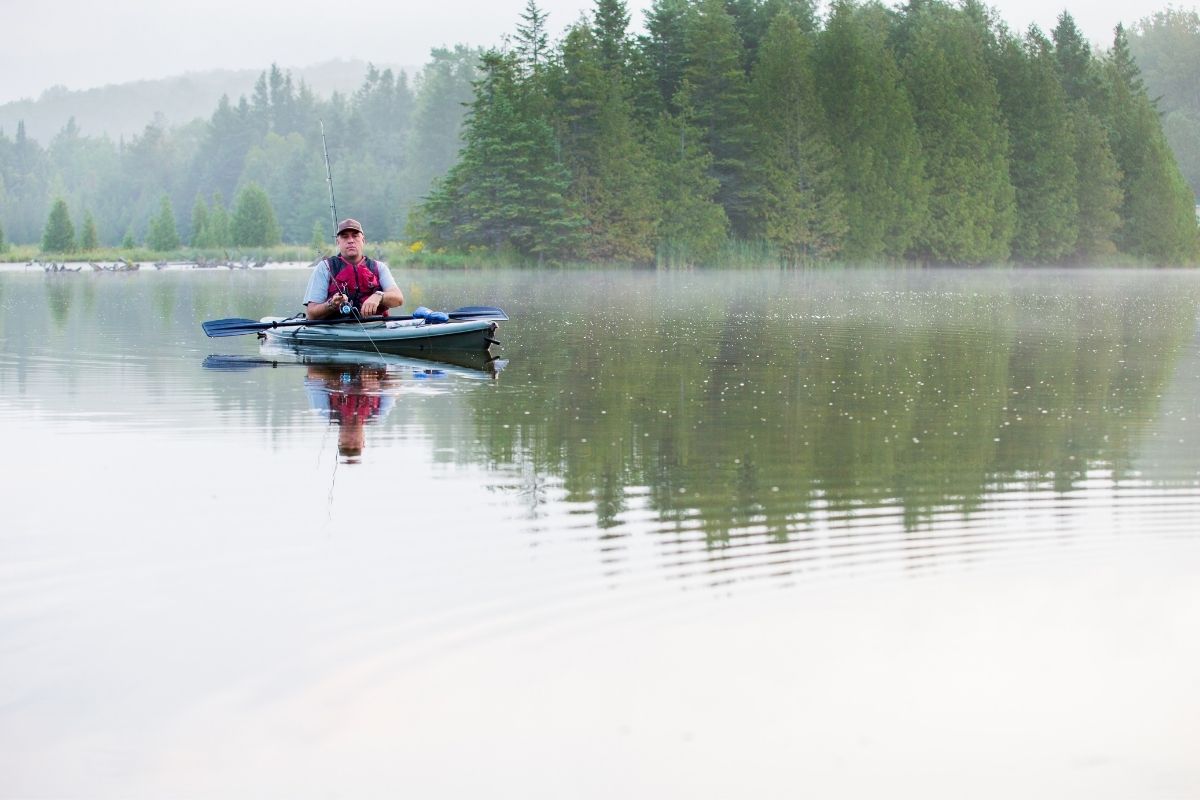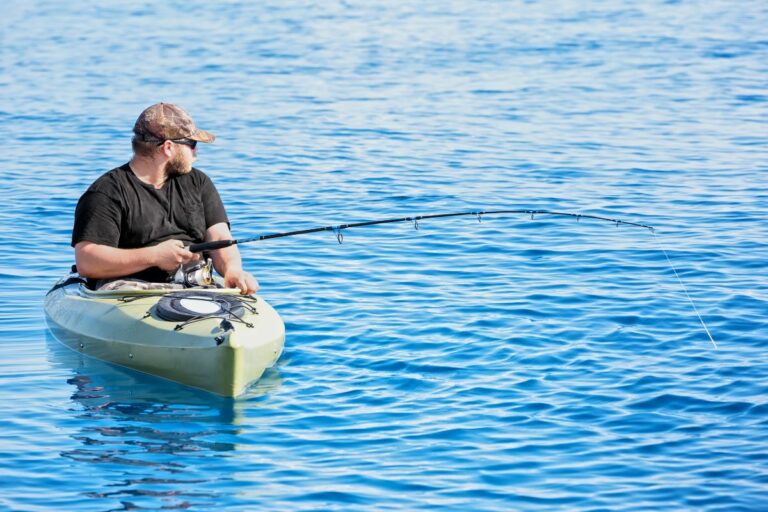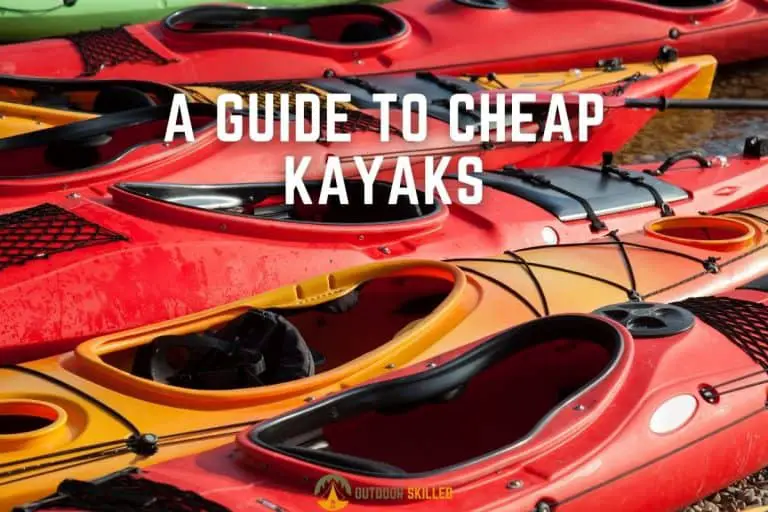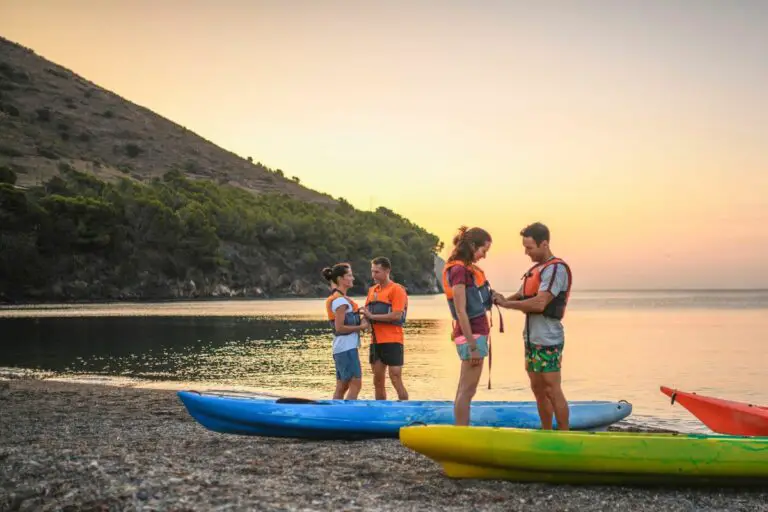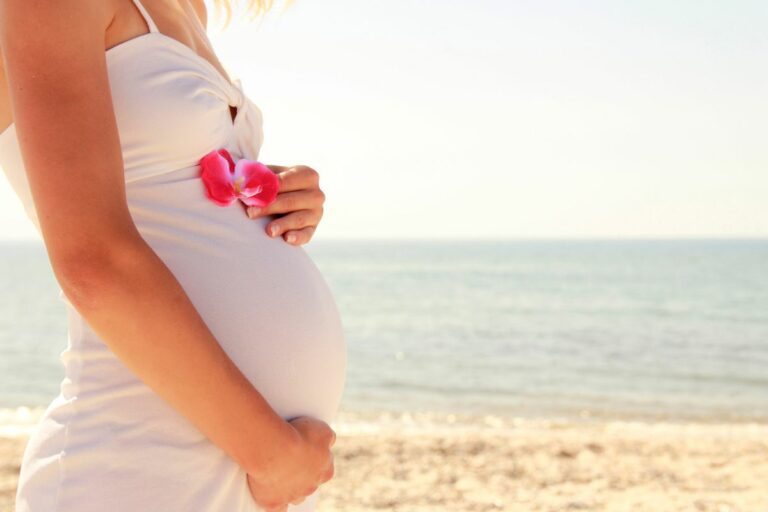Are Fishing Kayaks Slow? What You Should Know
Before setting out on a fishing trip in your kayak, it’s very important to have a good understanding of your kayak’s abilities.
Fishing kayaks are known to be slower than other kinds of kayaks. That’s why you need to know exactly how fast your fishing kayak can go and the factors that might affect its speed so you can time your trip correctly.
So, are fishing kayaks slow? Fish kayaks are slow compared to other kinds of kayaks because they are shorter and wider which reduces their speed but increases their stability. High speed isn’t a big requirement for a fishing kayak since anglers mostly stay in one spot while stability is highly crucial for casting accurately.
Keep reading to learn more about fishing kayaks and the factors that affect their performance on the water.
Table of Contents
What You Need to Know About Fishing Kayaks

Fishing kayaks are also known as sit-on-top kayaks or SOTs. They are designed specifically to accommodate all the needs of anglers and that design gives them many advantages as well as some disadvantages.
So, let’s break down all the pros and cons of fishing kayaks in more detail:
The Pros and Cons of Fishing Kayaks
Pros
- They’re easy to board and they can be easily re-entered from the water. They’re also easy maneuvers even if you’re completely new to kayaking.
- They’re basically unsinkable due to the lack of a cockpit and they’re less prone to capsizing.
- They are built with scupper holes at the bottom of the hull to drain out any water that enters the kayak.
- They have enough space to allow anglers a wide range of motion when casting their lines and reeling in the fish.
- They’re highly stable which allows anglers to focus on casting accurately without worrying about capsizing or losing their balance in the water.
- They come with multiple storage options to bring all the fishing gear you need including dry hatches and sealed compartments to prevent water from reaching your gear.
- They have a high weight capacity and most of them can withstand up to 500 pounds. This allows you to bring more gear on board as well as any fish you might catch.
- They come with some features that cannot be found in other kayaks such as built-in rod holders for your fishing rods and a standing platform that allow anglers to stand up while fishing to improve their casting accuracy.
- They can be easily customized and modified to fit more accessories including GPS devices or cameras. You can even add a rudder or a motor to enhance your kayak’s performance.
- They’re cheaper in price compared to other kinds of kayaks which is ideal if you’re a beginner purchasing your first kayak.
Cons
- They don’t have a cockpit so they offer little to no protection against the elements which makes them unsuitable for use in rough water and harsh conditions.
- They’re heavier in weight compared to other kinds of kayaks which make them difficult to transport to different locations.
- They’re slower compared to other kinds of kayaks so they require anglers to exert more effort to push them forward.
The Main Differences Between a Fishing Kayaks and a Regular Kayak

Now that you know the advantages and disadvantages of fishing kayaks, let’s take a look at the main differences that sets them apart from regular kayaks.
Design
Fishing kayaks have a sit-on-top design. They’re built without a cockpit, so kayakers will be positioned right on top of the kayak’s deck instead of sitting inside the hull.
Regular kayaks, on the other hand, have a sit-inside design. They are built with an enclosed cockpit, so the kayakers will be positioned inside the hull.
Size
Fishing kayaks are typically built shorter with wider beams. The average length of a fishing kayak ranges between 8 and 10 feet long while its width is around 35 inches.
Regular kayaks, on the other hand, are built longer with narrower beams. The average length ranges between 10 to 12 feet long while its width ranges between 27 to 30 inches.
The length and width of a kayak can have a great impact on its performance including its speed, tracking, and stability.
Stability
A kayak’s stability refers to its ability to resist capsizing and it’s mostly affected by the width of the kayak’s beam.
Fishing kayaks are built with wider beams than regular kayaks which means they have a higher center of gravity and a higher degree of primary stability.
Tracking
A kayak’s tracking refers to the ability of a kayak to move in a straight line and it’s mostly affected by the length of the kayak.
Regular kayaks are built longer than fishing kayaks which means they can track better.
Speed
The speed of the kayak is also affected by its length and width. Since regular kayaks are longer and narrower than fishing kayaks, they’re faster and they don’t require as much effort as fishing kayaks to cover larger distances of water.
Weight
Fishing kayaks are usually heavy in weight which makes them difficult to carry out of the water or transport to different locations.
Regular kayaks, on the other hand, are made from materials that are a lot lighter in weight which makes them more convenient for casual use as they will be easier to transport.
Storage
Fishing kayaks have more storage space than regular kayaks. That’s mostly because of the absence of a cockpit in their design.
They typically come with multiple storage options to keep all your fishing gear. Some of these storage options are even sealed to prevent water from reaching your equipment.
I have two more in-depth guides that are definitely worth your time to learn more about fishing kayaks and the differences between them and other kayaks types.
You should start with this sit-on-top vs sit-in fishing kayaks comparison and then check out this excellent simplified fishing vs recreational kayaks guide.
What Are Factors that Affect a Fishing Kayak’s Performance?
Your fishing kayak’s performance mainly comes down to its speed, tracking, and stability.
As mentioned before, some of these factors are related to the way the kayak is built including its length and width. The condition of the kayak will also affect its performance.
An older kayak might have some damage that comes with prolonged use. If the damage is limited to shallow cuts and small scrapes, it won’t really have any effect on its performance.
However, if there are any deep dents in the hull of the kayak, it might cause some issues with the kayak’s speed and stability.
That’s why it’s very important to properly maintain your kayak to keep it in a good condition. Make sure to frequently check it for signs of damage so you can make repairs accordingly. and take it out for test drives
There are some external factors that can affect the kayak’s performance. These factors are related to the kayaker’s skills including the paddling technique and the body posture.
What Is the Average Speed of a Fishing Kayak?
Most kayakers can reach an average of two miles per hour when paddling for multiple hours. A more skilled kayaker might reach an average speed of up to five miles per hour, however, this kind of speed can rarely be maintained for multiple hours at a time.
How to Choose the Right Kayak Size?
The length and width of your fishing kayak can have a significant effect on its speed and its stability.
If you value speed, it’s recommended to go for a longer, thinner fishing kayak. This will allow you to move faster in water without exerting too much effort because the bow of the kayak will slice through the water instead of having the water piling it up in front of the kayak and slowing it down.
However, if you value stability, it’s recommended to go for a shorter, wider kayak. That is because wider kayaks have a higher center of gravity, which means they have a higher degree of primary stability
How to Enhance Your Fishing Kayak’s Performance?
If you’re a skilled kayaker, you can easily enhance the performance of your fishing kayak regardless of its size. It mainly comes down to learning the proper paddling technique and improving your body posture.
Here are some tips you can follow to easily enhance the performance of your kayak to make it more stable and faster:
- You can try lowering the height of your seat to increase your center of gravity. Having a higher center of gravity will produce a higher degree of initial stability and will increase your overall balance.
- It’s best not to bring any unnecessary weight on board the kayak because added weight might reduce the speed of the kayak. It’s also a good idea to evenly distribute your weight and the weight of your gear throughout the kayak to help keep it more balanced.
- You can distribute your body weight more evenly by learning how to rotate your hips so you can shift your weight from one side to the other while avoiding putting more pressure on one side.
- Make sure you’re using the suitable type and size of paddle blades. It’s recommended to go for shorter paddles and feather blades for better stability and more speed.
- Practice holding your paddle properly. You need to maintain the paddler’s box position by keeping your hands a shoulder-width apart on the paddle and bending your elbows at a 90-degree angle.
- Avoid relying on your dominant hand only and try to apply equal amounts of force on the paddle blade using both of your hands. That is because your dominant hand is stronger which means it can dictate the direction of your kayak and prevent it from going straight.
- When paddling, make sure to match your paddle strokes on both sides of the kayak. Your paddle needs to be sweeping the water at the same distance from the kayak on each side. It also needs to hit the water with the same amount of force and not dip deeper on one side.
- Practice executing different paddle strokes as each kind will help serve a different purpose. Mastering various kinds of strokes will allow you more control over your kayak better and it will enhance your overall performance.
- Maintain a good body posture while paddling by keeping your body in an upright position. Make sure your spine is as straight as possible while your shoulders and stomach are more relaxed.
- It’s recommended to keep your legs bent to improve your balance. This will also help you rotate your upper body smoothly and give your arms more freedom to execute your strokes more efficiently.
- Rely on using your core muscles more when executing your paddle strokes. This will help you avoid getting tired quickly and reduce the risk of injury. You can also rely on the muscles in your arms and shoulders for additional support.
You can also check out this guide to making your kayak track better in 8 ways here.
Related Question
What Is the Theoretical Speed of a Kayak?
The theoretical speed of a kayak, also known as the hull speed, is the maximum speed that can be achieved by any kayak. It mainly depends on the length of the kayak and its value is measured in kilometers per hour. It can be calculated using the following formula: the square root of the length of the kayak multiplied by a factor of 4.5.
What Makes Longer Kayaks Faster?
The main reason why longer kayaks are faster is that they allow for a more gradual slope of movement in the water. This leads to decreasing the opposing drag and resistance the kayak meets while it is moving in a straight direction. Another reason longer kayaks are faster is that they have more volume which means they have more buoyancy and they float higher on the water.
Do Fishing Kayaks Flip Over Easily?
Fishing kayaks do not flip over easily. That is because their construction and sit-on-top design make them more stable and prevent them from capsizing. However, there are other factors that might cause a kayak to flip over such as the paddler’s technique or external factors such as heavy wind and current.
Here is a full guide explaining what it takes to flip over a kayak.
Does The Paddle Size Matter When Kayaking?
The paddle size does matter when kayaking. It’s important to have the correct paddle size as this will enhance your paddling technique and reduce fatigue. Choosing the correct paddle size depends on the size of your torso. Basically, the longer your torso is, the longer your paddle needs to be.
Helpful Resources
Kayak your way to Freedom
- On a budget? Check out the best fishing kayaks under $500 here and the best Fishing Kayaks under $1,000 here. Or Check the best Cheap Kayaks here.
- Going fishing? Here are the best Ocean fishing kayaks, and here are the best River Fishing Kayaks.
- You can also find the best Fly Fishing Kayaks here and the best Bass Fishing Boats here.
- A bit experienced? Check out the best modular kayaks here and the best tandem fishing kayaks here.
- Looking for something special? Check out my favorite Ducky kayaks here.
- Navigate your way with these awesome and beginner-friendly Kayak compasses.
- Going Hunting? These Duck hunting kayaks will give you an unfair advantage!
- Have a need for speed? These motorized kayaks will get you moving.
- Protect yourself from the sun with these Kayak shades, and make your kayak more comfortable with these Kayak seats.
- Keep your feet dry and warm with these superb Kayaking shoes.
- Going Kayaking in cold water? Stay warm with these Kayaking gloves.
- Paddle Less, Fish More with the Best Kayak Motors
- Looking to get a trolling motor on your kayak? Check out the best kayak trolling motor mounts here.
If you like this article, please share it or pin it, you can find the share buttons below. We will really appreciate it ❤️

